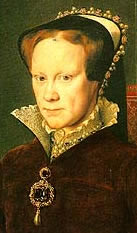I certainly do, from countless 21st birthday parties in the late eighties and early nineties. I saw this blast from the past at the Fashion Museum in Bath, which was great. Here is another:
Looks a bit like a dressing gown, I think. I would have described the colour as shocking pink or fuchsia, but the internet tells me it's more of a cerise. Love the dress below:
I think the colour is dusty pink? I couldn't picture an Elizabethan or medieval lady wearing the colour in the middle picture and so I started to do a search of colours used in clothing before aniline dyes were invented in the nineteenth century. I discovered this fantastic website which contains links to numerous websites concerned with Tudor costumes and portraiture. I determined, after many seconds of research, that in the olden days, popular colours for aristocratic women's clothing were red (in different hues), black, green and brown. Pastels weren't a big thing and I say "aristocratic women" specifically because portraits were usually of very wealthy women wearing their Court attire, which could cost more than a house. Sumptuary Laws dictated that only those in the upper tiers of the aristocracy could wear certain fabrics, colours and styles. This was to curb extravagance (apparently) and ensure you didn't mistake the cook for the Queen. Incidentally, during my researches I discovered that Queen Mary I and Dennis Waterman are actually twins:
Much red dye, incidentally, is made from crushed cochineal bugs found on prickly pears plants in Mexico. I learned from Ms Finlay's book that Buddhist monks won't used dyes made from cochineal because there is "too much death in it". You might reflect on that when next dabbing on red lipstick, which probably contain lots and lots of cochineal bug juice. Yum.
I have always been ambivalent about purple flowers in the garden, because the effect can be dull and lifeless. The Purple Border at Sissinghurst, though, was stunning. The yellow rose-hips, purply-pink dahlias and dark leaves on the stone wall made a perfect, jewel-like combination.








No comments:
Post a Comment